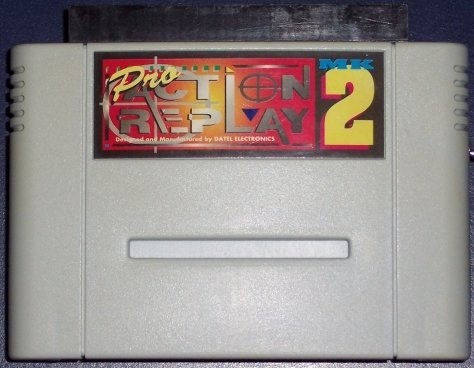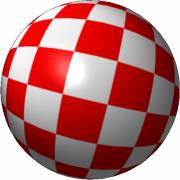Populous

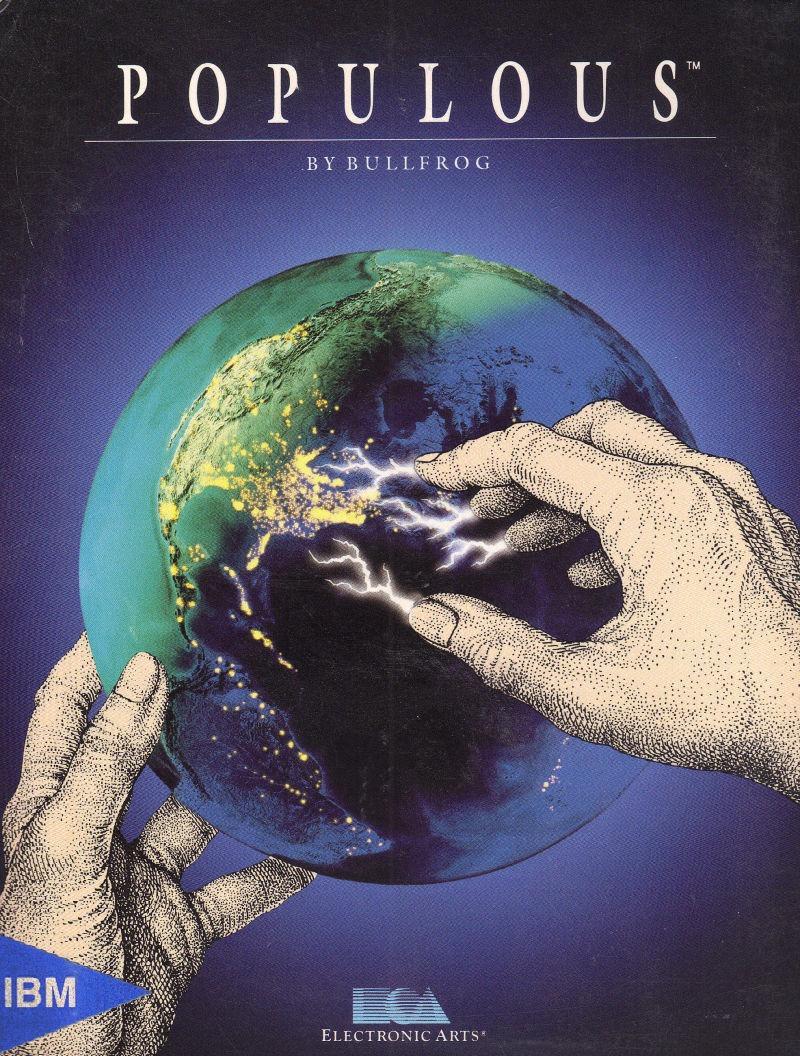
POPULOUS is proof that the ideal computer game is less the product of fantastic graphics, incredible screen resolution, and dynamite gameplay than the result of just the right combination of these three elements. This review is based on the Amiga version; IBM-PC and Atari ST version notes follow, along with data disk notes for THE PROMISED LANDS.
One of the most original computer games ever released, POPULOUS begs classification. I'd label it a strategy game with dynamic real-time elements: It's different from chess, in that you can take your time to figure out a move; but it's similar to chess, in that you must be sure to develop various strategies in response to the moves of your opponent. You must also keep the overall situation in mind, while limiting yourself to local strategic decisions.
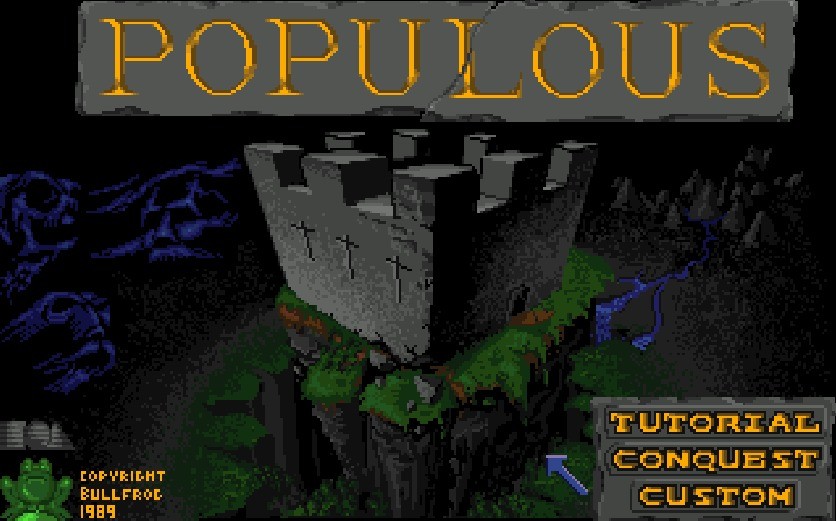
POPULOUS is a bit like SIMCITY, since it requires you to induce certain patterns of behavior in the on-screen characters, instead of putting you in control of an on-screen character or game element. It's like a wargame, because your opponent's main goal is the same as yours: to conquer as much of the game terrain as possible by whittling down the other side's expansion capabilities, while defending already-captured territory. It has something of a CRPG feel (without the variety of monsters, etc.), since you direct your side's leader to explore new areas, and organize his followers into concerted opposition against the other side. Finally, it's like an arcade/action game, in that your decisions must be made in real-time; at certain points, your success depends on the rapidity, placement, and efficiency of your actions.
Here's the basic plot: In Conquest mode, you are good and the other side is evil. (There is also a Custom mode, where you can choose sides and retain absolute control over all variables in the setup of gameplay.) You play a god to your people, and communicate with them through their high priest/leader, who serves as a sort of Moses (or equivalent religious leader/explorer -- choose your favorite analog). There are 500 different worlds pre-configured in Conquest mode, each one with a different (and very odd) name. You progress from Genesis (the first world) through all 500, as you conquer each one.
Once you conquer a world, you're given the name of the next one, which you can use to re-start the game another time. (This is a nice feature. Even though you can save games, you can also progress in the game _without_ saves if you wish; there's no need to repeat parts of the game you've already finished.)
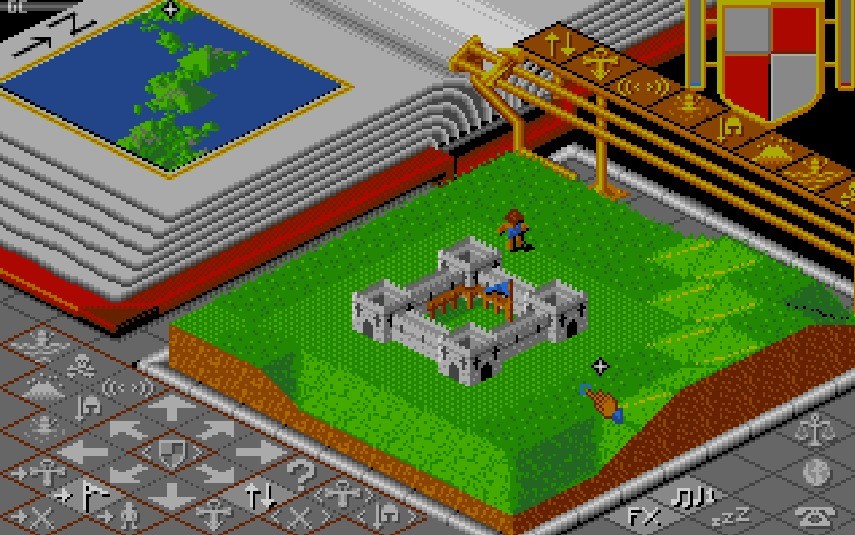
Conquering a world involves a number of separate but related elements: Your first priority is to get your people to settle over as broad an area as possible; your second priority is to increase your manna (your godly powers) in order to make use of various supernatural options. You can cause earthquakes, swamps, volcanoes, floods, and apocalypses, depending on how much manna you obtain. Your manna grows as your side's population expands. But it's not just a simple matter of expanding the population. You have to make sure your side has a "high priest," a carrier of the ankh; without this leader your people lose all direction and are easily defeated by the other side. Your leader can die as a result of inadequate land to build a home on, defeat in battle, or natural disaster induced by your opponent. Thus, you must keep a close watch on her even while scouting other areas. You may be a god, but your success requires following and taking care of your high priest as much it involves instructing her and your people in acts of conquest.
The "action" elements of the game come into play during the expansion phase. Not only can you instruct your people to settle new territory, worship at your "Papal Magnet" (it's an English game -- they love puns over there), or head out for battle, you also have to provide flat land for them to settle on. Each of the worlds starts out with a different map; some are mountainous, some are islands, some are full of swampy lowlands, some are alpine winter wastelands, some are sandy deserts. No matter which one you start with, you need to flatten the land. This is where the "strategic" part of the game surfaces, because the larger the flattened area, the more sophisticated and well-defended its buildings will be.
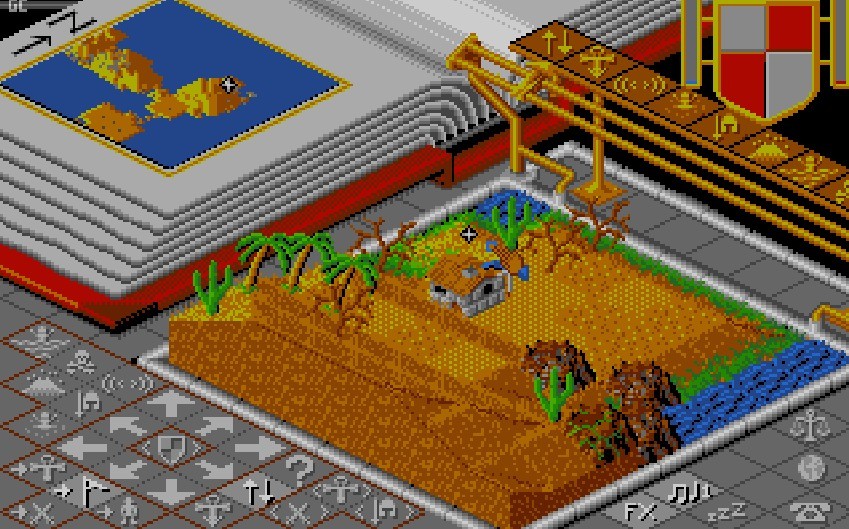
While you're flattening land and keeping an eye on your leader (i.e., jumping back and forth from place to place on the map), you must also keep watch on what the other side is doing. You'll need to anticipate when and where the other side will finally build up enough to launch an attack on your people; you must also gauge how much manna you think the other side has, and whether they'll use that manna to start visiting supernatural phenomena on your people. (There's no indicator for the other side's manna; you have to figure this out from the size of the population and the strength of its leader.) Along with this, you're also considering when and where to cause a disaster for the _other_ side.
If this sounds quite complex, you're right: The wondrous thing about POPULOUS is that the designers have provided a user interface that's incredibly easy to use, which allows you to spend your time playing the game instead of worrying about the controls. There is a range of icons situated around the edges of the close-up map, which you click on to initiate actions. These icons include: settle; go-to-Papal-Magnet and worship; engage-in-battle; query; place-Papal-Magnet; query settlements; find leader; find knight; scroll map; and initiate your disaster. Other icons let you access a series of screens to configure the Custom game. You can build a world from the ground up, and make all the choices that were automatically made in the Conquest series. There are also icons to initiate modem mode and game balance (in Custom mode); the latter allows you to increase or decrease the rate of each side's population growth and level of aggressiveness.
An option I haven't mentioned is one of the most amusing: When you've developed enough manna, you can transform your peace-loving high priest into rampaging, psychopathic knight. This character sets off for the other side's encampments, kills the residents, and burns their homes to the ground. (The fires are wonderfully animated on screen.) This has its obvious advantages, but there are also disadvantages: You have to dig out the terrain that's been destroyed before it can be settled by your side. (The knight's good when you're in a desperate state, but you'll have to clean up after her!)
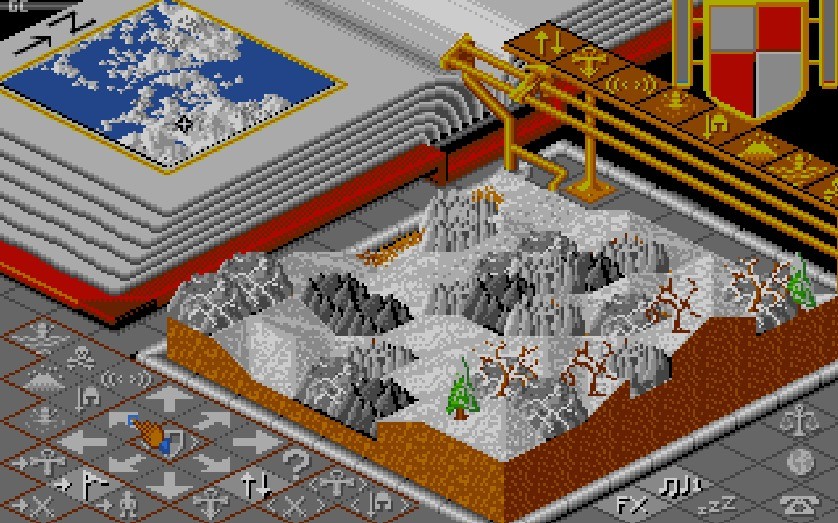
In the Amiga version, the sound effects are wonderful, and the eerie background music never grates. There are sounds for each of the disasters you cause, sounds of battle (the clash of swords), and an incessant heartbeat that speeds up when your side's in deep trouble. You can turn off either the music or the FX (separate icons for each), but if FX are off, you won't necessarily know whether your side's been volcanoed, swamped, etc. (Normally, you hear these disasters before you see them.) This is the sole weakness in the game's design: The heartbeat is linked to the sound effects, not the music. It'd be great to be able to eliminate that annoying heartbeat without losing the necessary sound effects. It's so realistic that when it speeds up, it tends to produce primal anxiety.
I played POPULOUS on an Amiga 500 with 1MB RAM total. POPULOUS doesn't require 1MB, but it'll make use of extra RAM, if available. The game is copy-protected with a key-disk system.
Even though there are only four different styles of terrain, the game never becomes monotonous. In each world your (and your opponent's) options vary: Sometimes you can swamp or volcano, sometimes you can't; sometimes your population will grow fast, sometimes very slowly. The levels from 0-23 are the easiest; from 23 up to about 83, things are more balanced. Beyond that, they're definitely in evil's favor, so you'll have to think hard about successful productive and destructive strategies.
POPULOUS is truly an outstanding game. Fans of almost any genre will enjoy this fascinating program. It's one of those terrific games you can either pick up and play for ten minutes, or devote dozens of hours to -- pausing only briefly for sleep and sustenance.
IBM-PC VERSION NOTES
POPULOUS, one of the more popular games of 1989, was converted to the IBM just before the end of the year. The IBM-PC version supports the following graphics modes: CGA, Hercules, Tandy, EGA, and VGA. Sound support includes Roland, AdLib, Tandy, and, of course, the standard PC speaker. A two-player mode (via modem) is provided. Keyboard, mouse, and joystick input are all supported, and a keyboard remapping utility is also included.
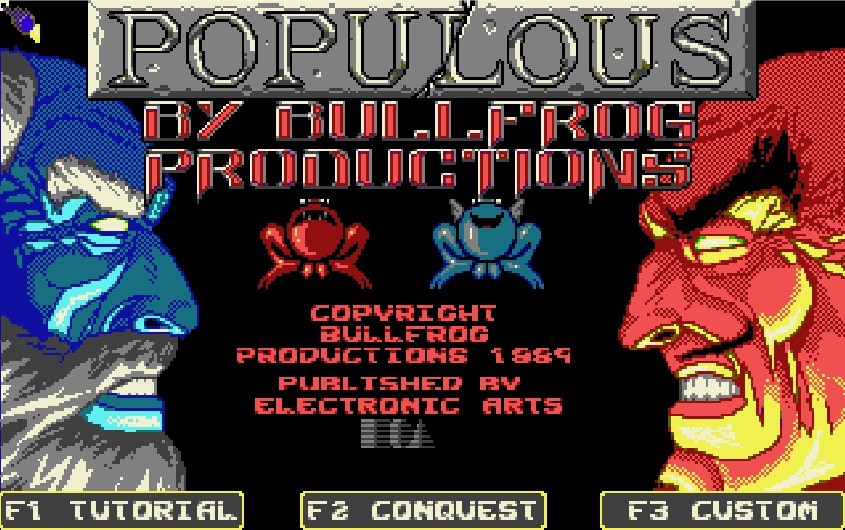
Copy protection is off-disk, involving entering the name of a world found in the documentation that matches a displayed icon. This needs to be done only at the beginning of play.
Another treat is the inclusion of THE PROMISED LANDS diskette. PROMISED LANDS, which was originally slated as an additional item for sale, offers new worlds to conquer. (Note: The 3-1/2" disk version does not include the PROMISED LANDS disk; apparently the 5-1/4" version is the only one that comes with the additional disk.)
As you might guess, the game looks absolutely stunning in VGA mode, rivaling the Amiga screen shots on the box. In EGA (and Tandy) mode, the graphics are as good (if not as stunning) as the VGA graphics. The chief difference is that the people are that horrid ochre so common in EGA games.
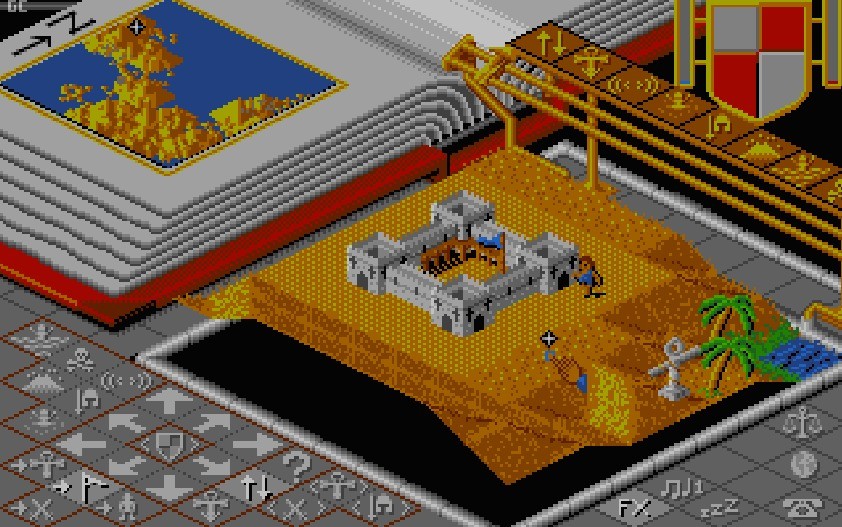
In CGA or Hercules mode, there is some significant information loss, in addition to the less attractive appearance of the game. The information loss comes from the fact that there are too few colors to use in some of the displays, so it's not possible to see the enemy walkers and villages in the world book. The game is playable without this, but it is a bit harder. An amusing "feature" in CGA mode is that the people lose their clothes! So, playing POPULOUS in CGA mode is like watching a naked nursery school class populating the world.
While I was unable to evaluate the sound board support, I can report that the PC sounds were quite acceptable and informative; however, the background music is grating if you don't have some kind of volume control. Fortunately, you can turn it off. You also don't hear the heartbeat that is mentioned in the Amiga review. I'm relatively certain it would occur if you were using a sound board.
This game will really show off a well-equipped PC. (Note that there is a keyboard command that permits you to alter game speed.) The graphics are outstanding in VGA, and the mouse interface is extremely well done. The game is every bit as addictive as Amiga players have claimed. The only fly in the ointment is that I cannot recommend the game wholeheartedly to CGA owners. They can play it in that mode, but much will be lost.
ATARI ST VERSION NOTES
With the exception of complete copy protection, the Atari ST version of POPULOUS is identical to the Amiga version. In fact, it's so identical that the instruction manual for the Amiga is the instruction manual for the ST: No reference card is provided; indeed, none is needed. Whereas the Amiga used key disk protection, the ST disk cannot be backed up at all.
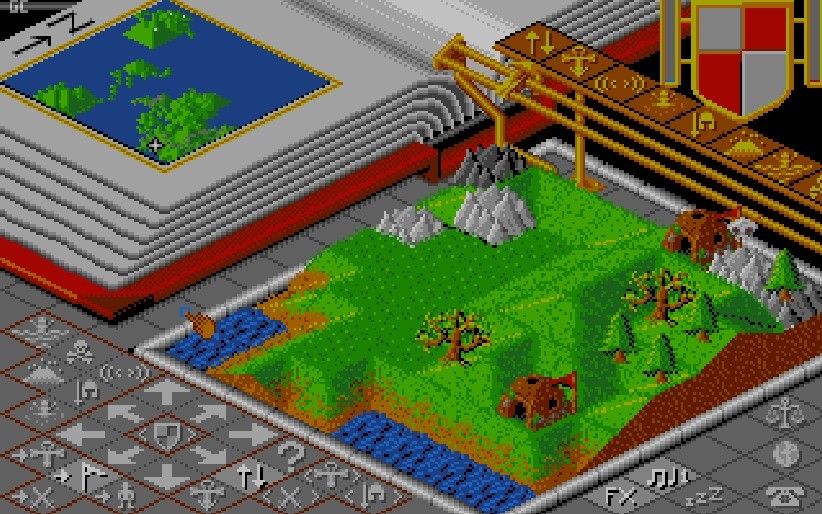
Graphics, animation, and sound effects are superb throughout. The game played like a charm, and it certainly did make the time slip away.
You might find POPULOUS even more absorbing by overlooking the "...it lets the user play God..." hype, which is pretentious at best: An excellent package cannot be made more so by being swathed in religious paper. POPULOUS has my blessing.
THE PROMISED LANDS DATA DISK NOTES (ATARI ST VERSION)
THE PROMISED LANDS is a "world data disk" for use with POPULOUS, the incredibly popular strategy/arcade/adventure simulation. It offers five new landscapes: Silly World, Blockland, Wild West, Revolution Francaise, and the Bit Plains.
You must have POPULOUS to use the data disk, and if you don't already have the game, you should buy it immediately. POPULOUS's 3-D graphics are excellent, the digitized sounds are sparingly used, the mouse interface is perfection, and the game is as absorbing and as addictive as any you'll ever play: Think of SIMCITY as it might have been programmed on Mount Olympus. While you're buying POPULOUS, you might as well get THE PROMISED LANDS disk, too: The graphic and animation wonders of POPULOUS remain the same, as do the names of the landscapes. The differences lie in the appearances of the landscapes, and the walkers that populate them.
Blockland could be called "Legoland," which is a good explanation for why it wasn't; the Wild West has an American frontier theme, with cowboys and indians as walkers; the walkers of Silly World seem related to the green slimers from GHOST BUSTERS -- the ones always pigging out on hot dogs; and in the Revolution Francaise landscape, you can construct a palace that's been modelled on Versailles; the Bit Plains is most entertaining, with its landscape of cigarette butts, coffee cups, stubby pencils, and computer terminals.
THE PROMISED LANDS package for the ST comes with one copy-protected disk and an instruction sheet that explains how to access the landscapes, a long-winded process that must be followed exactly. The sheet also points out that new strategies are necessary, and that the landscapes might be more difficult, which is just two ways of saying the same thing. Some of the tougher screens -- the ones whose evil walkers begin with disaster control and who clear space at a frightening clip -- somehow seemed easier; it's hard to say for sure. New strategies helped (at least I think so), but events on those troublesome worlds moved along so swiftly that I'm not at all certain what I did differently, or even if I actually did _anything_ differently.
Be that as it may, the five new worlds of THE PROMISED LANDS give POPULOUS a fresh look, which in no way makes light of its current look. No matter what the deities of Bullfrog and EA might say, THE PROMISED LANDS data disk is not a necessity; any world, regardless of its basic appearance, becomes a blur in the heat of play. It's a neat luxury though, and as such, certainly deserves your consideration.
POPULOUS is published and distributed by Electronic Arts.










